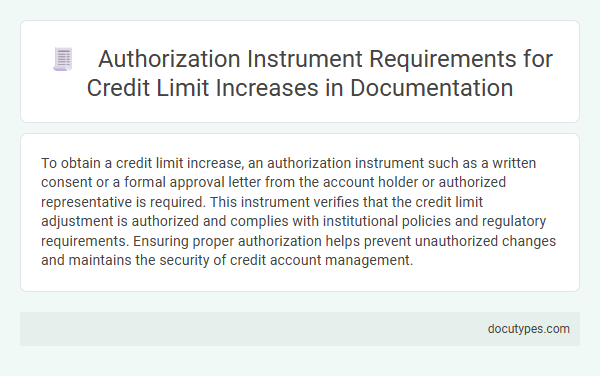To obtain a credit limit increase, an authorization instrument such as a written consent or a formal approval letter from the account holder or authorized representative is required. This instrument verifies that the credit limit adjustment is authorized and complies with institutional policies and regulatory requirements. Ensuring proper authorization helps prevent unauthorized changes and maintains the security of credit account management.
Overview of Authorization Instruments in Credit Limit Increases
Authorization instruments define the formal approvals required to increase credit limits within financial institutions. These instruments ensure that credit limit adjustments comply with organizational policies and risk management frameworks.
- Board Resolution - A formal document approved by the board of directors authorizing credit limit adjustments above a certain threshold.
- Credit Committee Approval - A designated credit committee reviews and approves credit limit increases based on credit assessments and risk appetite.
- Managerial Authorization - Senior management can grant approval for smaller or routine credit limit increases within predefined limits.
Regulatory Guidelines for Authorization Documentation
| Authorization Instrument | Regulatory Guidelines | Documentation Requirements |
|---|---|---|
| Formal Authorization Letter | Must comply with financial regulatory authority standards, such as those set by the FDIC or OCC in the United States. | Includes specific credit limit increase details, authorized signatories' names, and validation dates. Should be signed and dated by an authorized officer. |
| Board Resolution | Required under regulatory compliance frameworks, particularly for corporate credit accounts. | Resolution must explicitly state the approved credit limit increase, reference the meeting date, and be documented in official minutes. |
| Power of Attorney (POA) | Recognized by regulatory bodies as a valid authorization instrument when properly executed. | Must clearly specify authority limits related to credit limit adjustments, include notarization, and be periodically reviewed for validity. |
| Credit Authorization Form | Guided by internal compliance policies aligned with external regulatory requirements. | Contains detailed credit limit increase terms, customer or authorized representative signature, and date of authorization. |
| Digital Authorization with e-Signature | Conforms to electronic transaction laws such as ESIGN Act or eIDAS regulations for digital authorizations. | Requires secure, verifiable electronic signatures and audit trail documentation ensuring authenticity and authorization legitimacy. |
Your credit limit increase request must be supported by one of these regulatory-compliant authorization instruments to ensure valid approval and audit readiness.
Essential Components of Authorization Instruments
Authorization instruments for credit limit increases must include clear terms, specified approval authority, and documentation of consent. These components ensure compliance and secure approval processes.
Essential components include the scope of authorization, detailing who can approve and the extent of allowed increases. Documentation must capture all approvals to provide an audit trail. Properly structured instruments protect both the lender and borrower interests.
Signature and Approval Protocols
Authorization instruments required for credit limit increases primarily include signed approval forms and documented authorization protocols. Signature verification ensures that only authorized personnel can approve changes, maintaining security and compliance. Approval protocols outline the necessary steps and responsible parties for validating credit limit adjustments, reducing the risk of unauthorized modifications.
Document Retention and Recordkeeping Requirements
Authorization instruments required for credit limit increases must comply with strict document retention and recordkeeping requirements to ensure regulatory adherence. Financial institutions are obligated to retain authorization records, including signed agreements and approval documentation, for a minimum period specified by governing bodies, often five to seven years. Proper maintenance of these records facilitates audits, dispute resolution, and ongoing compliance with credit regulations.
Digital Versus Physical Authorization Instruments
Authorization instruments for credit limit increases vary between digital and physical formats. Digital authorization methods include electronic signatures, OTPs (One-Time Passwords), and biometric verification that ensure swift and secure approval processes.
Physical authorization involves signed paper forms or written letters requiring manual review and confirmation. You must choose the appropriate instrument based on your institution's security protocols and customer convenience preferences.
Compliance Verification for Credit Limit Authorizations
Credit limit increases require specific authorization instruments to ensure compliance with financial regulations and internal policies. Regulatory frameworks such as the Equal Credit Opportunity Act (ECOA) and the Truth in Lending Act (TILA) mandate proper documentation and approval processes for such adjustments.
Compliance verification involves validating the authorization against approved credit policies and audit trails. Your credit management system must capture the authorized signatures or electronic approvals to maintain accountability and regulatory adherence.
Audit Trails and Monitoring Responsibilities
Which authorization instrument is needed for credit limit increases? The primary authorization instrument required is a formal approval from designated credit officers within your organization. Audit trails must document all approvals to ensure transparency and accountability.
How do audit trails support credit limit increase requests? Audit trails provide a detailed record of who approved the increase, when it was approved, and under what conditions. These records help in monitoring compliance and reviewing authorization processes.
What are the monitoring responsibilities for credit limit increases? Monitoring involves regularly reviewing credit limit changes to detect unauthorized modifications or policy breaches. Your compliance team should use audit trails to verify that all credit limit increases follow proper authorization protocols.
Common Pitfalls in Authorization Documentation
Authorization instruments are essential for approving credit limit increases, ensuring compliance and control. Common pitfalls in authorization documentation can lead to delays or compliance issues.
- Incomplete Authorization Forms - Missing signatures or insufficient details can invalidate the approval process.
- Lack of Clear Delegation - Failure to specify who has the authority to approve limits creates confusion and unauthorized approvals.
- Outdated Documentation - Using obsolete authorization instruments risks non-compliance with current policies and regulations.
Which Authorization Instrument Is Needed for Credit Limit Increases? Infographic

